Analysis of Australian Mental Health Policies for Young People
VerifiedAdded on 2022/08/27
|23
|5663
|27
Report
AI Summary
This report analyzes the effectiveness of Australian mental health policies in addressing the needs of the younger generation. It begins with an introduction highlighting the prevalence of mental health issues in Australia, particularly among young people, and the government's efforts to address these challenges through various policies. The report outlines the research question, which focuses on how effectively these policies cater to the youth. It then details the qualitative research design, including the selection of document analysis as the primary method, and the secondary data collection method used to gather information from various sources. The data analysis section describes the thematic analysis and systematic review methods employed to identify key themes and patterns within the policies. The report also addresses ethical considerations, ensuring proper citation and avoidance of plagiarism. The results section presents the key objectives and principles of five major mental health policies, including the South Australia’s Mental Health and Wellbeing Policy and the NSW Aboriginal Mental Health and Well Being Policy. The discussion section interprets the findings, and the report concludes with recommendations for improving mental health policies and services for young Australians.
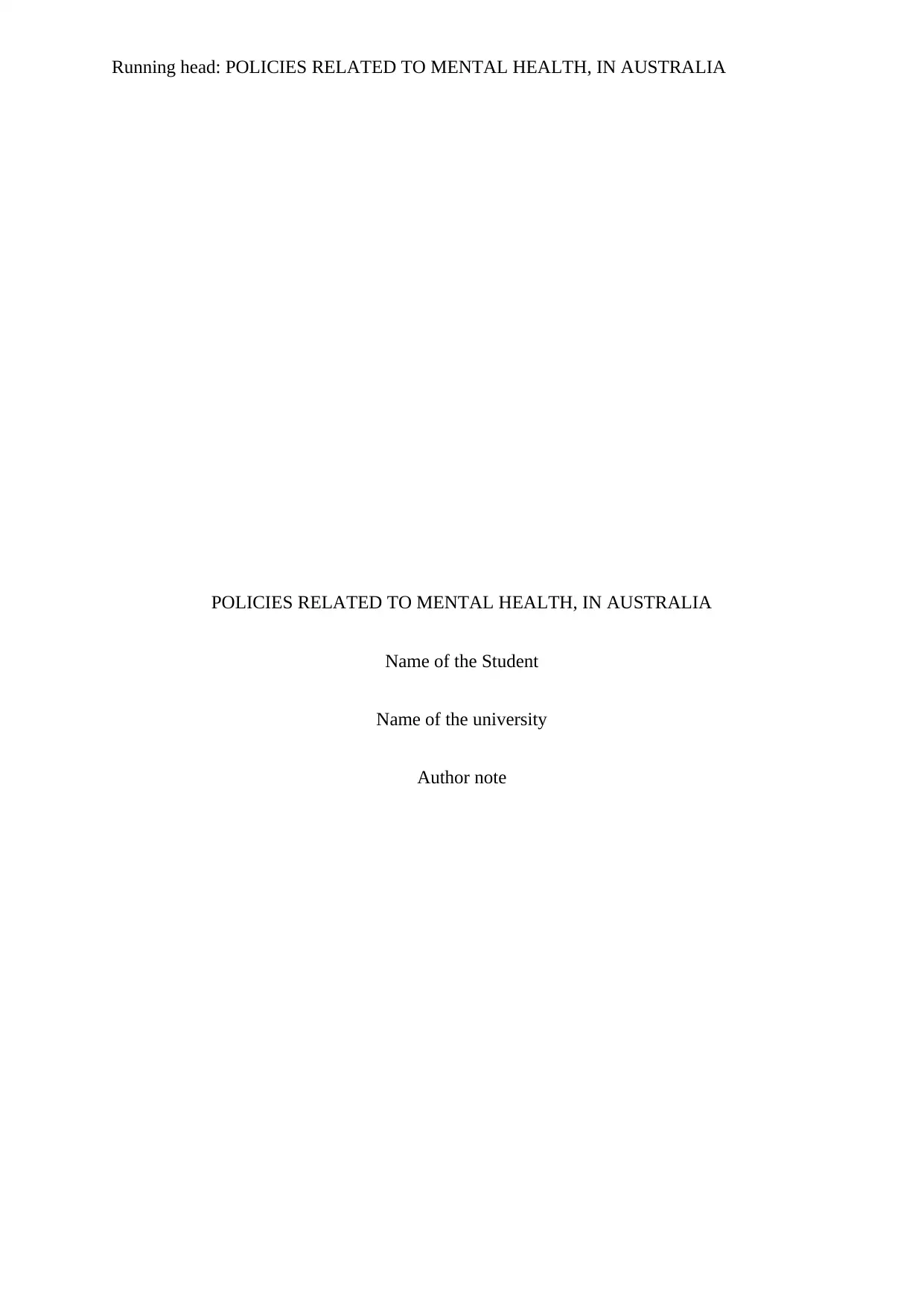
Running head: POLICIES RELATED TO MENTAL HEALTH, IN AUSTRALIA
POLICIES RELATED TO MENTAL HEALTH, IN AUSTRALIA
Name of the Student
Name of the university
Author note
POLICIES RELATED TO MENTAL HEALTH, IN AUSTRALIA
Name of the Student
Name of the university
Author note
Paraphrase This Document
Need a fresh take? Get an instant paraphrase of this document with our AI Paraphraser
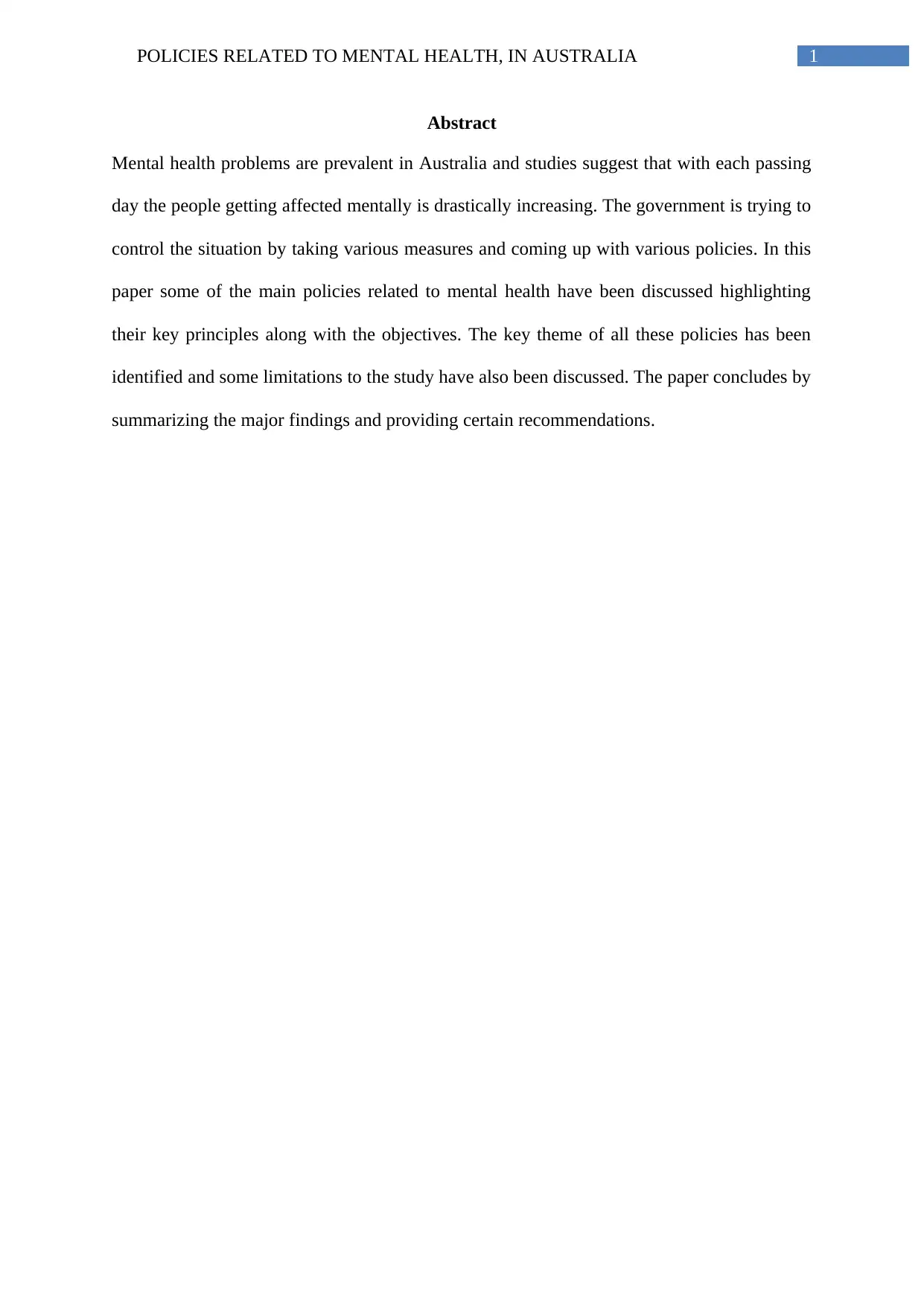
1POLICIES RELATED TO MENTAL HEALTH, IN AUSTRALIA
Abstract
Mental health problems are prevalent in Australia and studies suggest that with each passing
day the people getting affected mentally is drastically increasing. The government is trying to
control the situation by taking various measures and coming up with various policies. In this
paper some of the main policies related to mental health have been discussed highlighting
their key principles along with the objectives. The key theme of all these policies has been
identified and some limitations to the study have also been discussed. The paper concludes by
summarizing the major findings and providing certain recommendations.
Abstract
Mental health problems are prevalent in Australia and studies suggest that with each passing
day the people getting affected mentally is drastically increasing. The government is trying to
control the situation by taking various measures and coming up with various policies. In this
paper some of the main policies related to mental health have been discussed highlighting
their key principles along with the objectives. The key theme of all these policies has been
identified and some limitations to the study have also been discussed. The paper concludes by
summarizing the major findings and providing certain recommendations.
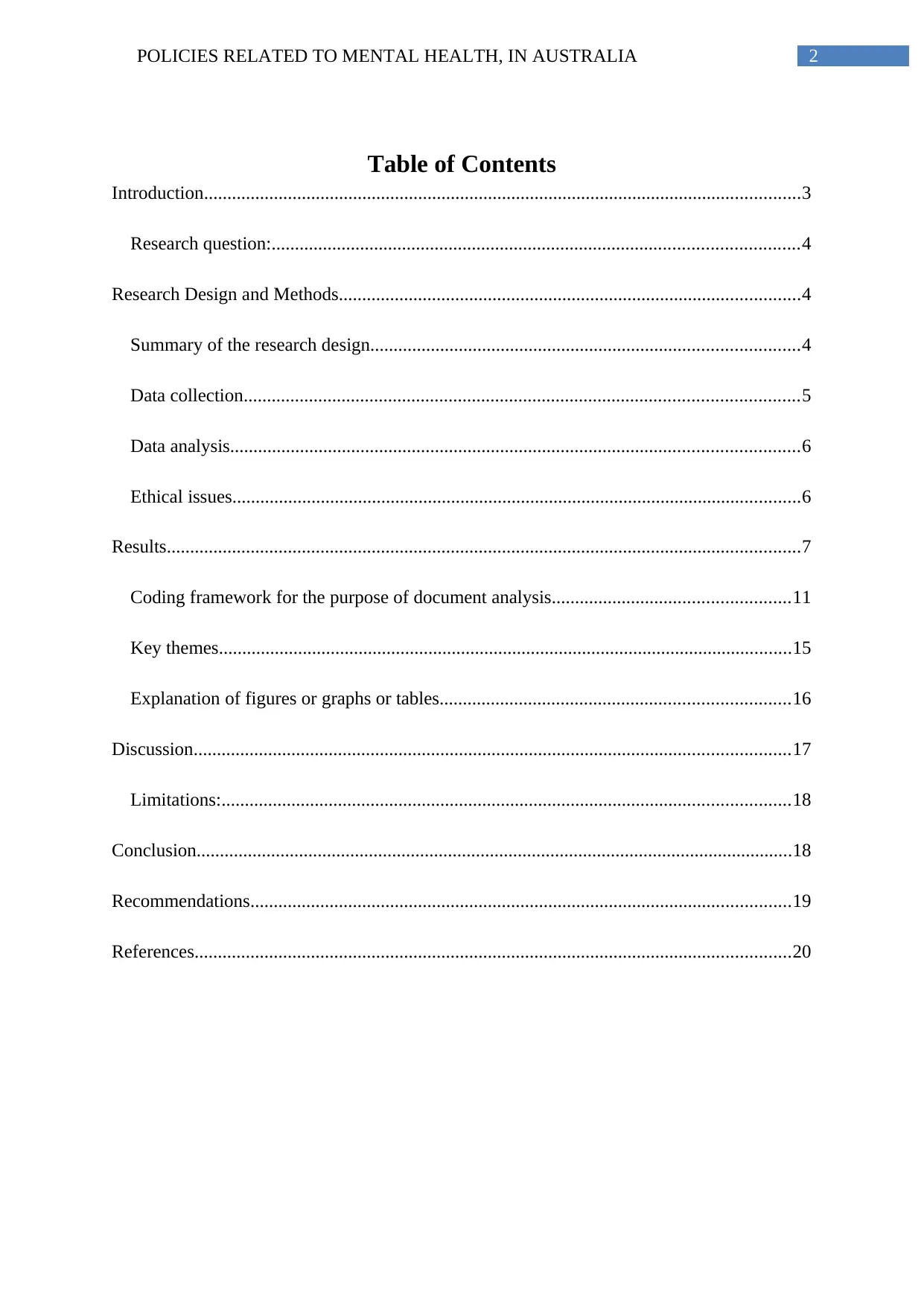
2POLICIES RELATED TO MENTAL HEALTH, IN AUSTRALIA
Table of Contents
Introduction................................................................................................................................3
Research question:.................................................................................................................4
Research Design and Methods...................................................................................................4
Summary of the research design............................................................................................4
Data collection.......................................................................................................................5
Data analysis..........................................................................................................................6
Ethical issues..........................................................................................................................6
Results........................................................................................................................................7
Coding framework for the purpose of document analysis...................................................11
Key themes...........................................................................................................................15
Explanation of figures or graphs or tables...........................................................................16
Discussion................................................................................................................................17
Limitations:..........................................................................................................................18
Conclusion................................................................................................................................18
Recommendations....................................................................................................................19
References................................................................................................................................20
Table of Contents
Introduction................................................................................................................................3
Research question:.................................................................................................................4
Research Design and Methods...................................................................................................4
Summary of the research design............................................................................................4
Data collection.......................................................................................................................5
Data analysis..........................................................................................................................6
Ethical issues..........................................................................................................................6
Results........................................................................................................................................7
Coding framework for the purpose of document analysis...................................................11
Key themes...........................................................................................................................15
Explanation of figures or graphs or tables...........................................................................16
Discussion................................................................................................................................17
Limitations:..........................................................................................................................18
Conclusion................................................................................................................................18
Recommendations....................................................................................................................19
References................................................................................................................................20
⊘ This is a preview!⊘
Do you want full access?
Subscribe today to unlock all pages.

Trusted by 1+ million students worldwide
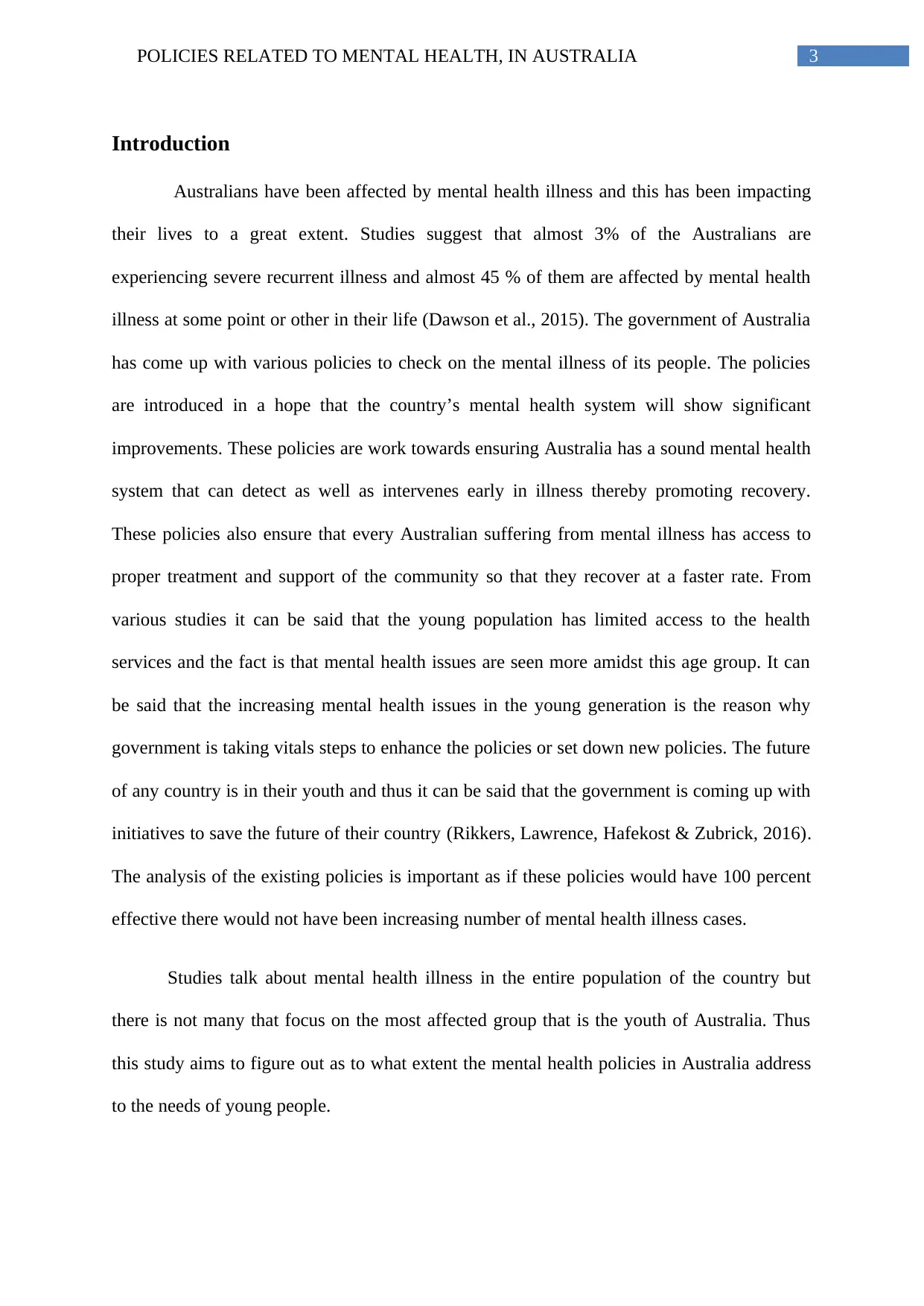
3POLICIES RELATED TO MENTAL HEALTH, IN AUSTRALIA
Introduction
Australians have been affected by mental health illness and this has been impacting
their lives to a great extent. Studies suggest that almost 3% of the Australians are
experiencing severe recurrent illness and almost 45 % of them are affected by mental health
illness at some point or other in their life (Dawson et al., 2015). The government of Australia
has come up with various policies to check on the mental illness of its people. The policies
are introduced in a hope that the country’s mental health system will show significant
improvements. These policies are work towards ensuring Australia has a sound mental health
system that can detect as well as intervenes early in illness thereby promoting recovery.
These policies also ensure that every Australian suffering from mental illness has access to
proper treatment and support of the community so that they recover at a faster rate. From
various studies it can be said that the young population has limited access to the health
services and the fact is that mental health issues are seen more amidst this age group. It can
be said that the increasing mental health issues in the young generation is the reason why
government is taking vitals steps to enhance the policies or set down new policies. The future
of any country is in their youth and thus it can be said that the government is coming up with
initiatives to save the future of their country (Rikkers, Lawrence, Hafekost & Zubrick, 2016).
The analysis of the existing policies is important as if these policies would have 100 percent
effective there would not have been increasing number of mental health illness cases.
Studies talk about mental health illness in the entire population of the country but
there is not many that focus on the most affected group that is the youth of Australia. Thus
this study aims to figure out as to what extent the mental health policies in Australia address
to the needs of young people.
Introduction
Australians have been affected by mental health illness and this has been impacting
their lives to a great extent. Studies suggest that almost 3% of the Australians are
experiencing severe recurrent illness and almost 45 % of them are affected by mental health
illness at some point or other in their life (Dawson et al., 2015). The government of Australia
has come up with various policies to check on the mental illness of its people. The policies
are introduced in a hope that the country’s mental health system will show significant
improvements. These policies are work towards ensuring Australia has a sound mental health
system that can detect as well as intervenes early in illness thereby promoting recovery.
These policies also ensure that every Australian suffering from mental illness has access to
proper treatment and support of the community so that they recover at a faster rate. From
various studies it can be said that the young population has limited access to the health
services and the fact is that mental health issues are seen more amidst this age group. It can
be said that the increasing mental health issues in the young generation is the reason why
government is taking vitals steps to enhance the policies or set down new policies. The future
of any country is in their youth and thus it can be said that the government is coming up with
initiatives to save the future of their country (Rikkers, Lawrence, Hafekost & Zubrick, 2016).
The analysis of the existing policies is important as if these policies would have 100 percent
effective there would not have been increasing number of mental health illness cases.
Studies talk about mental health illness in the entire population of the country but
there is not many that focus on the most affected group that is the youth of Australia. Thus
this study aims to figure out as to what extent the mental health policies in Australia address
to the needs of young people.
Paraphrase This Document
Need a fresh take? Get an instant paraphrase of this document with our AI Paraphraser
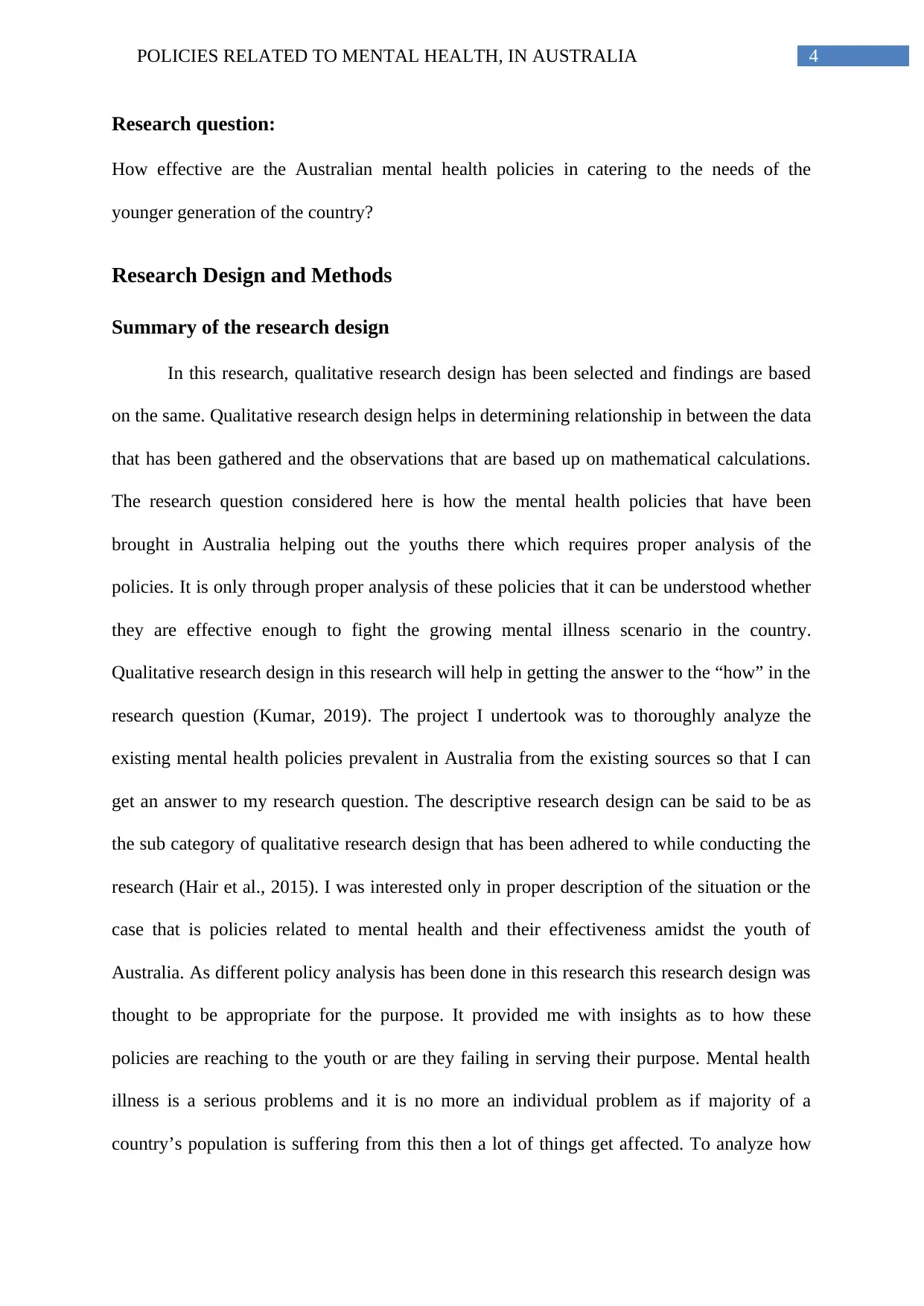
4POLICIES RELATED TO MENTAL HEALTH, IN AUSTRALIA
Research question:
How effective are the Australian mental health policies in catering to the needs of the
younger generation of the country?
Research Design and Methods
Summary of the research design
In this research, qualitative research design has been selected and findings are based
on the same. Qualitative research design helps in determining relationship in between the data
that has been gathered and the observations that are based up on mathematical calculations.
The research question considered here is how the mental health policies that have been
brought in Australia helping out the youths there which requires proper analysis of the
policies. It is only through proper analysis of these policies that it can be understood whether
they are effective enough to fight the growing mental illness scenario in the country.
Qualitative research design in this research will help in getting the answer to the “how” in the
research question (Kumar, 2019). The project I undertook was to thoroughly analyze the
existing mental health policies prevalent in Australia from the existing sources so that I can
get an answer to my research question. The descriptive research design can be said to be as
the sub category of qualitative research design that has been adhered to while conducting the
research (Hair et al., 2015). I was interested only in proper description of the situation or the
case that is policies related to mental health and their effectiveness amidst the youth of
Australia. As different policy analysis has been done in this research this research design was
thought to be appropriate for the purpose. It provided me with insights as to how these
policies are reaching to the youth or are they failing in serving their purpose. Mental health
illness is a serious problems and it is no more an individual problem as if majority of a
country’s population is suffering from this then a lot of things get affected. To analyze how
Research question:
How effective are the Australian mental health policies in catering to the needs of the
younger generation of the country?
Research Design and Methods
Summary of the research design
In this research, qualitative research design has been selected and findings are based
on the same. Qualitative research design helps in determining relationship in between the data
that has been gathered and the observations that are based up on mathematical calculations.
The research question considered here is how the mental health policies that have been
brought in Australia helping out the youths there which requires proper analysis of the
policies. It is only through proper analysis of these policies that it can be understood whether
they are effective enough to fight the growing mental illness scenario in the country.
Qualitative research design in this research will help in getting the answer to the “how” in the
research question (Kumar, 2019). The project I undertook was to thoroughly analyze the
existing mental health policies prevalent in Australia from the existing sources so that I can
get an answer to my research question. The descriptive research design can be said to be as
the sub category of qualitative research design that has been adhered to while conducting the
research (Hair et al., 2015). I was interested only in proper description of the situation or the
case that is policies related to mental health and their effectiveness amidst the youth of
Australia. As different policy analysis has been done in this research this research design was
thought to be appropriate for the purpose. It provided me with insights as to how these
policies are reaching to the youth or are they failing in serving their purpose. Mental health
illness is a serious problems and it is no more an individual problem as if majority of a
country’s population is suffering from this then a lot of things get affected. To analyze how
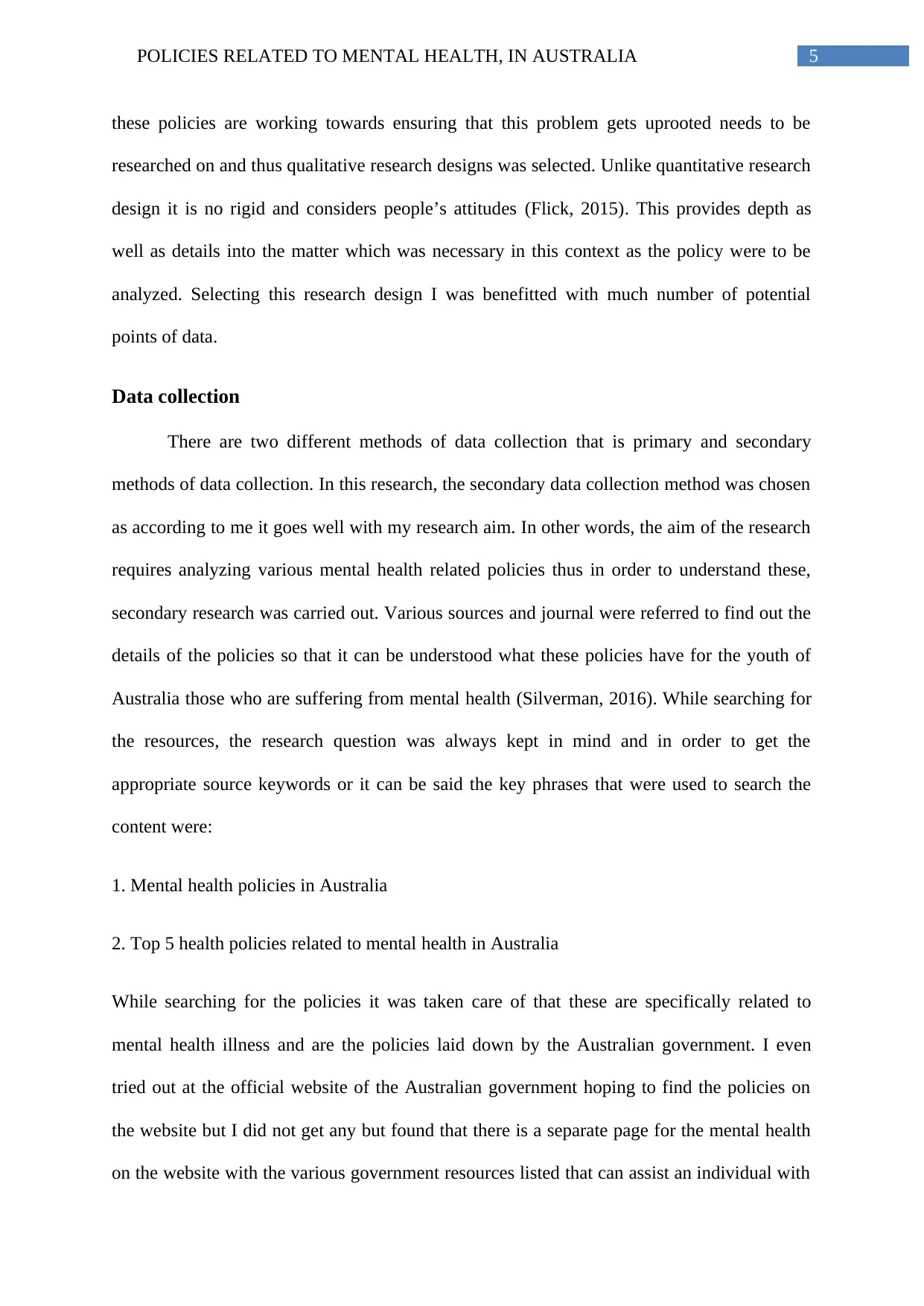
5POLICIES RELATED TO MENTAL HEALTH, IN AUSTRALIA
these policies are working towards ensuring that this problem gets uprooted needs to be
researched on and thus qualitative research designs was selected. Unlike quantitative research
design it is no rigid and considers people’s attitudes (Flick, 2015). This provides depth as
well as details into the matter which was necessary in this context as the policy were to be
analyzed. Selecting this research design I was benefitted with much number of potential
points of data.
Data collection
There are two different methods of data collection that is primary and secondary
methods of data collection. In this research, the secondary data collection method was chosen
as according to me it goes well with my research aim. In other words, the aim of the research
requires analyzing various mental health related policies thus in order to understand these,
secondary research was carried out. Various sources and journal were referred to find out the
details of the policies so that it can be understood what these policies have for the youth of
Australia those who are suffering from mental health (Silverman, 2016). While searching for
the resources, the research question was always kept in mind and in order to get the
appropriate source keywords or it can be said the key phrases that were used to search the
content were:
1. Mental health policies in Australia
2. Top 5 health policies related to mental health in Australia
While searching for the policies it was taken care of that these are specifically related to
mental health illness and are the policies laid down by the Australian government. I even
tried out at the official website of the Australian government hoping to find the policies on
the website but I did not get any but found that there is a separate page for the mental health
on the website with the various government resources listed that can assist an individual with
these policies are working towards ensuring that this problem gets uprooted needs to be
researched on and thus qualitative research designs was selected. Unlike quantitative research
design it is no rigid and considers people’s attitudes (Flick, 2015). This provides depth as
well as details into the matter which was necessary in this context as the policy were to be
analyzed. Selecting this research design I was benefitted with much number of potential
points of data.
Data collection
There are two different methods of data collection that is primary and secondary
methods of data collection. In this research, the secondary data collection method was chosen
as according to me it goes well with my research aim. In other words, the aim of the research
requires analyzing various mental health related policies thus in order to understand these,
secondary research was carried out. Various sources and journal were referred to find out the
details of the policies so that it can be understood what these policies have for the youth of
Australia those who are suffering from mental health (Silverman, 2016). While searching for
the resources, the research question was always kept in mind and in order to get the
appropriate source keywords or it can be said the key phrases that were used to search the
content were:
1. Mental health policies in Australia
2. Top 5 health policies related to mental health in Australia
While searching for the policies it was taken care of that these are specifically related to
mental health illness and are the policies laid down by the Australian government. I even
tried out at the official website of the Australian government hoping to find the policies on
the website but I did not get any but found that there is a separate page for the mental health
on the website with the various government resources listed that can assist an individual with
⊘ This is a preview!⊘
Do you want full access?
Subscribe today to unlock all pages.

Trusted by 1+ million students worldwide
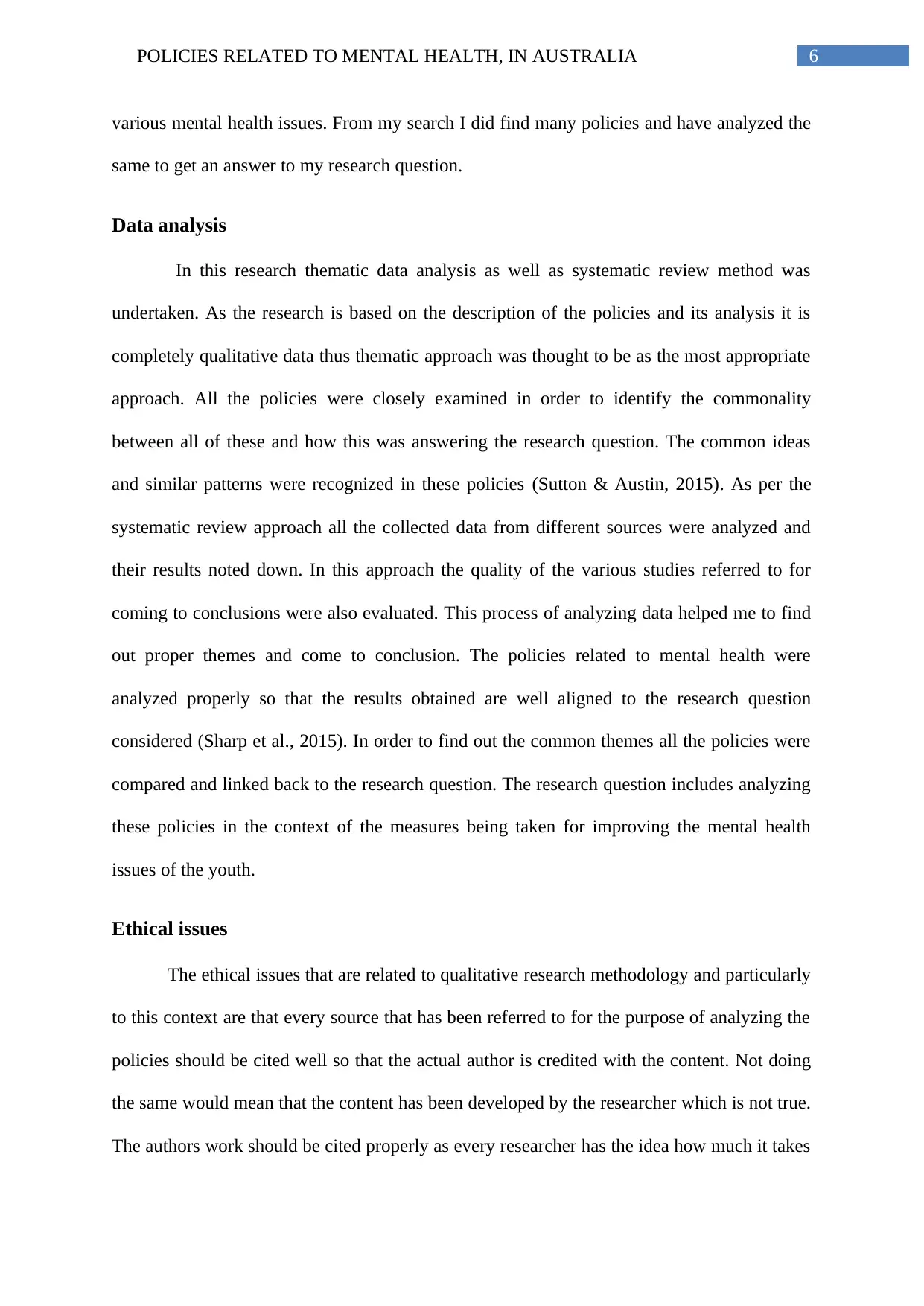
6POLICIES RELATED TO MENTAL HEALTH, IN AUSTRALIA
various mental health issues. From my search I did find many policies and have analyzed the
same to get an answer to my research question.
Data analysis
In this research thematic data analysis as well as systematic review method was
undertaken. As the research is based on the description of the policies and its analysis it is
completely qualitative data thus thematic approach was thought to be as the most appropriate
approach. All the policies were closely examined in order to identify the commonality
between all of these and how this was answering the research question. The common ideas
and similar patterns were recognized in these policies (Sutton & Austin, 2015). As per the
systematic review approach all the collected data from different sources were analyzed and
their results noted down. In this approach the quality of the various studies referred to for
coming to conclusions were also evaluated. This process of analyzing data helped me to find
out proper themes and come to conclusion. The policies related to mental health were
analyzed properly so that the results obtained are well aligned to the research question
considered (Sharp et al., 2015). In order to find out the common themes all the policies were
compared and linked back to the research question. The research question includes analyzing
these policies in the context of the measures being taken for improving the mental health
issues of the youth.
Ethical issues
The ethical issues that are related to qualitative research methodology and particularly
to this context are that every source that has been referred to for the purpose of analyzing the
policies should be cited well so that the actual author is credited with the content. Not doing
the same would mean that the content has been developed by the researcher which is not true.
The authors work should be cited properly as every researcher has the idea how much it takes
various mental health issues. From my search I did find many policies and have analyzed the
same to get an answer to my research question.
Data analysis
In this research thematic data analysis as well as systematic review method was
undertaken. As the research is based on the description of the policies and its analysis it is
completely qualitative data thus thematic approach was thought to be as the most appropriate
approach. All the policies were closely examined in order to identify the commonality
between all of these and how this was answering the research question. The common ideas
and similar patterns were recognized in these policies (Sutton & Austin, 2015). As per the
systematic review approach all the collected data from different sources were analyzed and
their results noted down. In this approach the quality of the various studies referred to for
coming to conclusions were also evaluated. This process of analyzing data helped me to find
out proper themes and come to conclusion. The policies related to mental health were
analyzed properly so that the results obtained are well aligned to the research question
considered (Sharp et al., 2015). In order to find out the common themes all the policies were
compared and linked back to the research question. The research question includes analyzing
these policies in the context of the measures being taken for improving the mental health
issues of the youth.
Ethical issues
The ethical issues that are related to qualitative research methodology and particularly
to this context are that every source that has been referred to for the purpose of analyzing the
policies should be cited well so that the actual author is credited with the content. Not doing
the same would mean that the content has been developed by the researcher which is not true.
The authors work should be cited properly as every researcher has the idea how much it takes
Paraphrase This Document
Need a fresh take? Get an instant paraphrase of this document with our AI Paraphraser
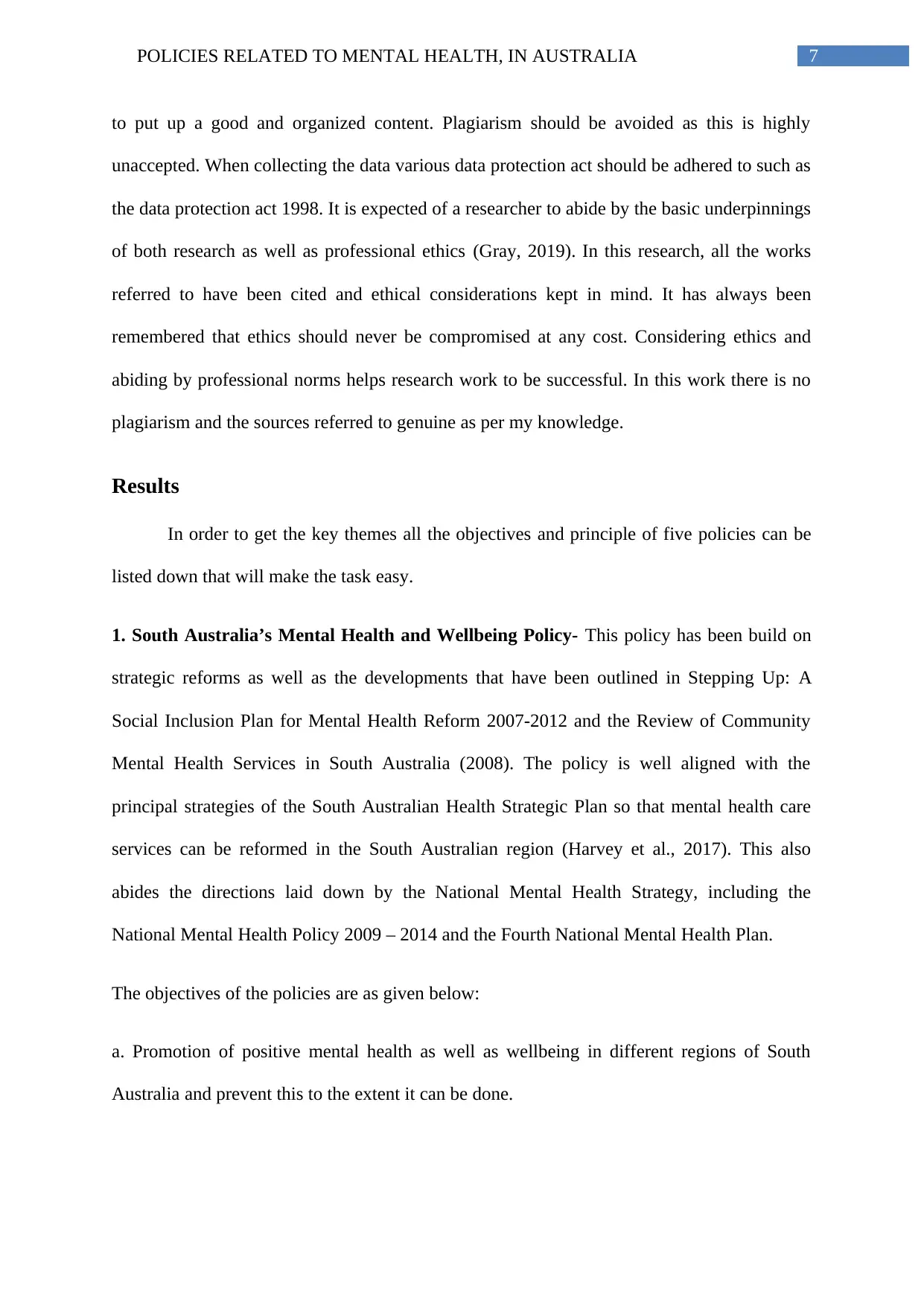
7POLICIES RELATED TO MENTAL HEALTH, IN AUSTRALIA
to put up a good and organized content. Plagiarism should be avoided as this is highly
unaccepted. When collecting the data various data protection act should be adhered to such as
the data protection act 1998. It is expected of a researcher to abide by the basic underpinnings
of both research as well as professional ethics (Gray, 2019). In this research, all the works
referred to have been cited and ethical considerations kept in mind. It has always been
remembered that ethics should never be compromised at any cost. Considering ethics and
abiding by professional norms helps research work to be successful. In this work there is no
plagiarism and the sources referred to genuine as per my knowledge.
Results
In order to get the key themes all the objectives and principle of five policies can be
listed down that will make the task easy.
1. South Australia’s Mental Health and Wellbeing Policy- This policy has been build on
strategic reforms as well as the developments that have been outlined in Stepping Up: A
Social Inclusion Plan for Mental Health Reform 2007-2012 and the Review of Community
Mental Health Services in South Australia (2008). The policy is well aligned with the
principal strategies of the South Australian Health Strategic Plan so that mental health care
services can be reformed in the South Australian region (Harvey et al., 2017). This also
abides the directions laid down by the National Mental Health Strategy, including the
National Mental Health Policy 2009 – 2014 and the Fourth National Mental Health Plan.
The objectives of the policies are as given below:
a. Promotion of positive mental health as well as wellbeing in different regions of South
Australia and prevent this to the extent it can be done.
to put up a good and organized content. Plagiarism should be avoided as this is highly
unaccepted. When collecting the data various data protection act should be adhered to such as
the data protection act 1998. It is expected of a researcher to abide by the basic underpinnings
of both research as well as professional ethics (Gray, 2019). In this research, all the works
referred to have been cited and ethical considerations kept in mind. It has always been
remembered that ethics should never be compromised at any cost. Considering ethics and
abiding by professional norms helps research work to be successful. In this work there is no
plagiarism and the sources referred to genuine as per my knowledge.
Results
In order to get the key themes all the objectives and principle of five policies can be
listed down that will make the task easy.
1. South Australia’s Mental Health and Wellbeing Policy- This policy has been build on
strategic reforms as well as the developments that have been outlined in Stepping Up: A
Social Inclusion Plan for Mental Health Reform 2007-2012 and the Review of Community
Mental Health Services in South Australia (2008). The policy is well aligned with the
principal strategies of the South Australian Health Strategic Plan so that mental health care
services can be reformed in the South Australian region (Harvey et al., 2017). This also
abides the directions laid down by the National Mental Health Strategy, including the
National Mental Health Policy 2009 – 2014 and the Fourth National Mental Health Plan.
The objectives of the policies are as given below:
a. Promotion of positive mental health as well as wellbeing in different regions of South
Australia and prevent this to the extent it can be done.
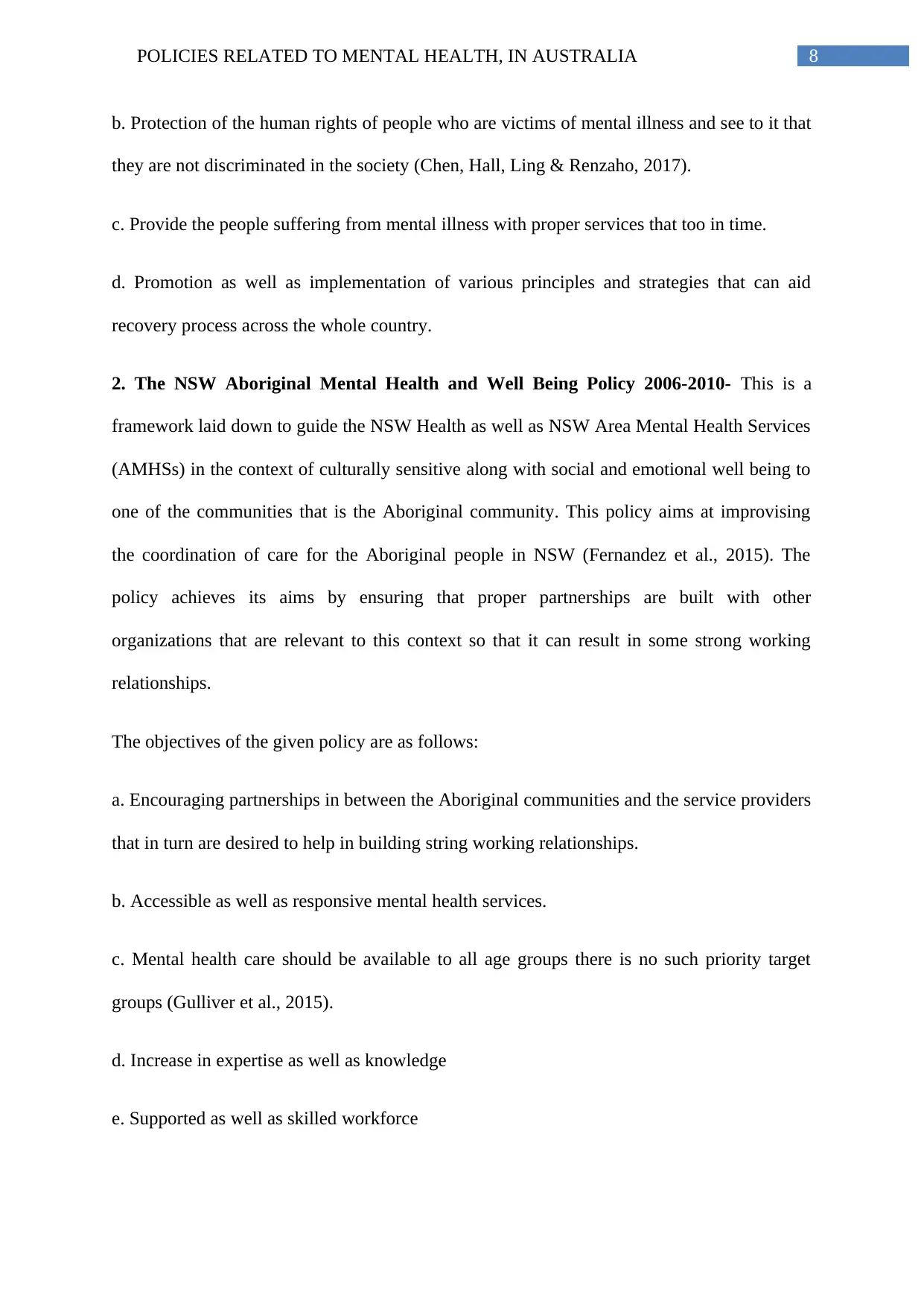
8POLICIES RELATED TO MENTAL HEALTH, IN AUSTRALIA
b. Protection of the human rights of people who are victims of mental illness and see to it that
they are not discriminated in the society (Chen, Hall, Ling & Renzaho, 2017).
c. Provide the people suffering from mental illness with proper services that too in time.
d. Promotion as well as implementation of various principles and strategies that can aid
recovery process across the whole country.
2. The NSW Aboriginal Mental Health and Well Being Policy 2006-2010- This is a
framework laid down to guide the NSW Health as well as NSW Area Mental Health Services
(AMHSs) in the context of culturally sensitive along with social and emotional well being to
one of the communities that is the Aboriginal community. This policy aims at improvising
the coordination of care for the Aboriginal people in NSW (Fernandez et al., 2015). The
policy achieves its aims by ensuring that proper partnerships are built with other
organizations that are relevant to this context so that it can result in some strong working
relationships.
The objectives of the given policy are as follows:
a. Encouraging partnerships in between the Aboriginal communities and the service providers
that in turn are desired to help in building string working relationships.
b. Accessible as well as responsive mental health services.
c. Mental health care should be available to all age groups there is no such priority target
groups (Gulliver et al., 2015).
d. Increase in expertise as well as knowledge
e. Supported as well as skilled workforce
b. Protection of the human rights of people who are victims of mental illness and see to it that
they are not discriminated in the society (Chen, Hall, Ling & Renzaho, 2017).
c. Provide the people suffering from mental illness with proper services that too in time.
d. Promotion as well as implementation of various principles and strategies that can aid
recovery process across the whole country.
2. The NSW Aboriginal Mental Health and Well Being Policy 2006-2010- This is a
framework laid down to guide the NSW Health as well as NSW Area Mental Health Services
(AMHSs) in the context of culturally sensitive along with social and emotional well being to
one of the communities that is the Aboriginal community. This policy aims at improvising
the coordination of care for the Aboriginal people in NSW (Fernandez et al., 2015). The
policy achieves its aims by ensuring that proper partnerships are built with other
organizations that are relevant to this context so that it can result in some strong working
relationships.
The objectives of the given policy are as follows:
a. Encouraging partnerships in between the Aboriginal communities and the service providers
that in turn are desired to help in building string working relationships.
b. Accessible as well as responsive mental health services.
c. Mental health care should be available to all age groups there is no such priority target
groups (Gulliver et al., 2015).
d. Increase in expertise as well as knowledge
e. Supported as well as skilled workforce
⊘ This is a preview!⊘
Do you want full access?
Subscribe today to unlock all pages.

Trusted by 1+ million students worldwide
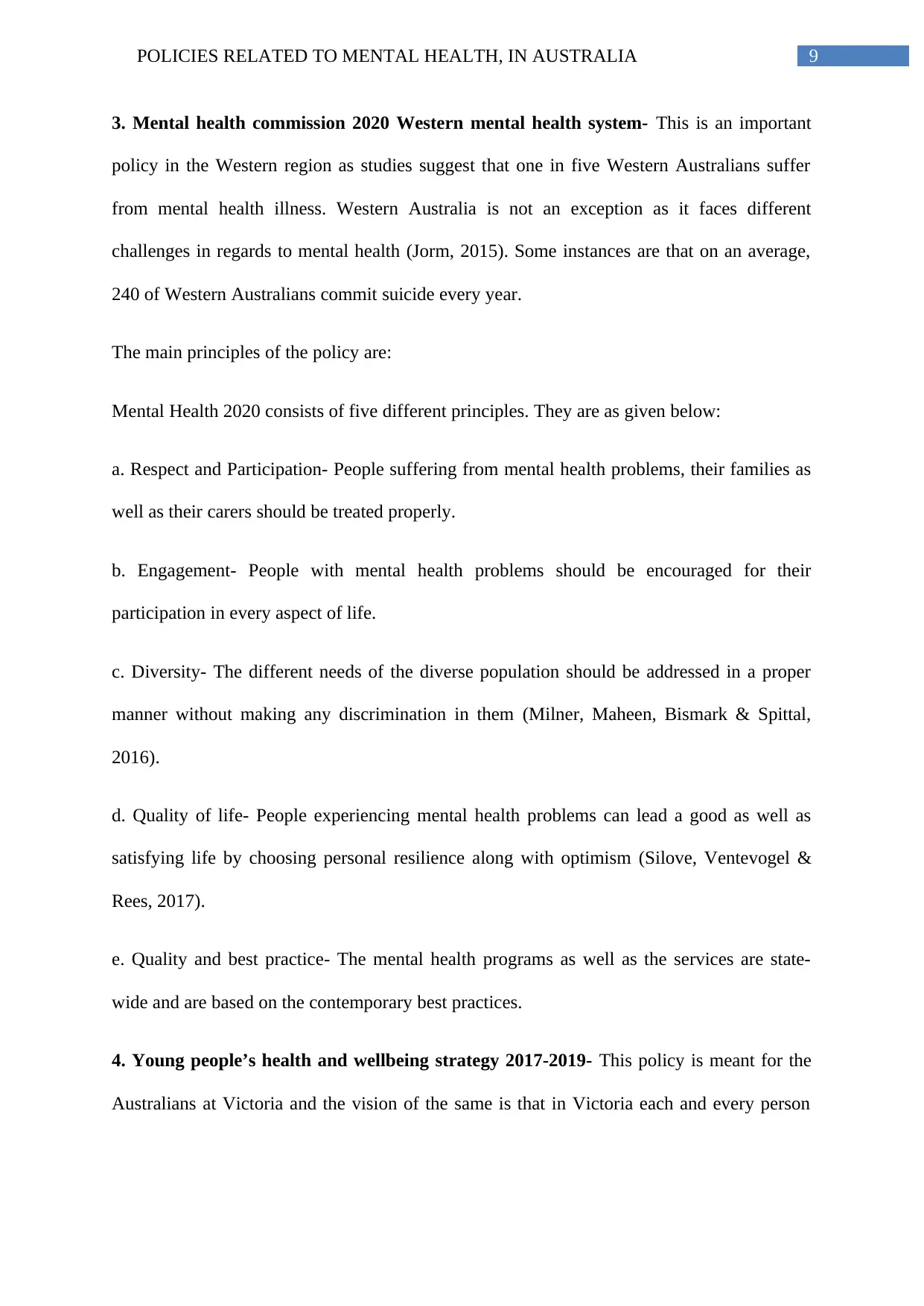
9POLICIES RELATED TO MENTAL HEALTH, IN AUSTRALIA
3. Mental health commission 2020 Western mental health system- This is an important
policy in the Western region as studies suggest that one in five Western Australians suffer
from mental health illness. Western Australia is not an exception as it faces different
challenges in regards to mental health (Jorm, 2015). Some instances are that on an average,
240 of Western Australians commit suicide every year.
The main principles of the policy are:
Mental Health 2020 consists of five different principles. They are as given below:
a. Respect and Participation- People suffering from mental health problems, their families as
well as their carers should be treated properly.
b. Engagement- People with mental health problems should be encouraged for their
participation in every aspect of life.
c. Diversity- The different needs of the diverse population should be addressed in a proper
manner without making any discrimination in them (Milner, Maheen, Bismark & Spittal,
2016).
d. Quality of life- People experiencing mental health problems can lead a good as well as
satisfying life by choosing personal resilience along with optimism (Silove, Ventevogel &
Rees, 2017).
e. Quality and best practice- The mental health programs as well as the services are state-
wide and are based on the contemporary best practices.
4. Young people’s health and wellbeing strategy 2017-2019- This policy is meant for the
Australians at Victoria and the vision of the same is that in Victoria each and every person
3. Mental health commission 2020 Western mental health system- This is an important
policy in the Western region as studies suggest that one in five Western Australians suffer
from mental health illness. Western Australia is not an exception as it faces different
challenges in regards to mental health (Jorm, 2015). Some instances are that on an average,
240 of Western Australians commit suicide every year.
The main principles of the policy are:
Mental Health 2020 consists of five different principles. They are as given below:
a. Respect and Participation- People suffering from mental health problems, their families as
well as their carers should be treated properly.
b. Engagement- People with mental health problems should be encouraged for their
participation in every aspect of life.
c. Diversity- The different needs of the diverse population should be addressed in a proper
manner without making any discrimination in them (Milner, Maheen, Bismark & Spittal,
2016).
d. Quality of life- People experiencing mental health problems can lead a good as well as
satisfying life by choosing personal resilience along with optimism (Silove, Ventevogel &
Rees, 2017).
e. Quality and best practice- The mental health programs as well as the services are state-
wide and are based on the contemporary best practices.
4. Young people’s health and wellbeing strategy 2017-2019- This policy is meant for the
Australians at Victoria and the vision of the same is that in Victoria each and every person
Paraphrase This Document
Need a fresh take? Get an instant paraphrase of this document with our AI Paraphraser
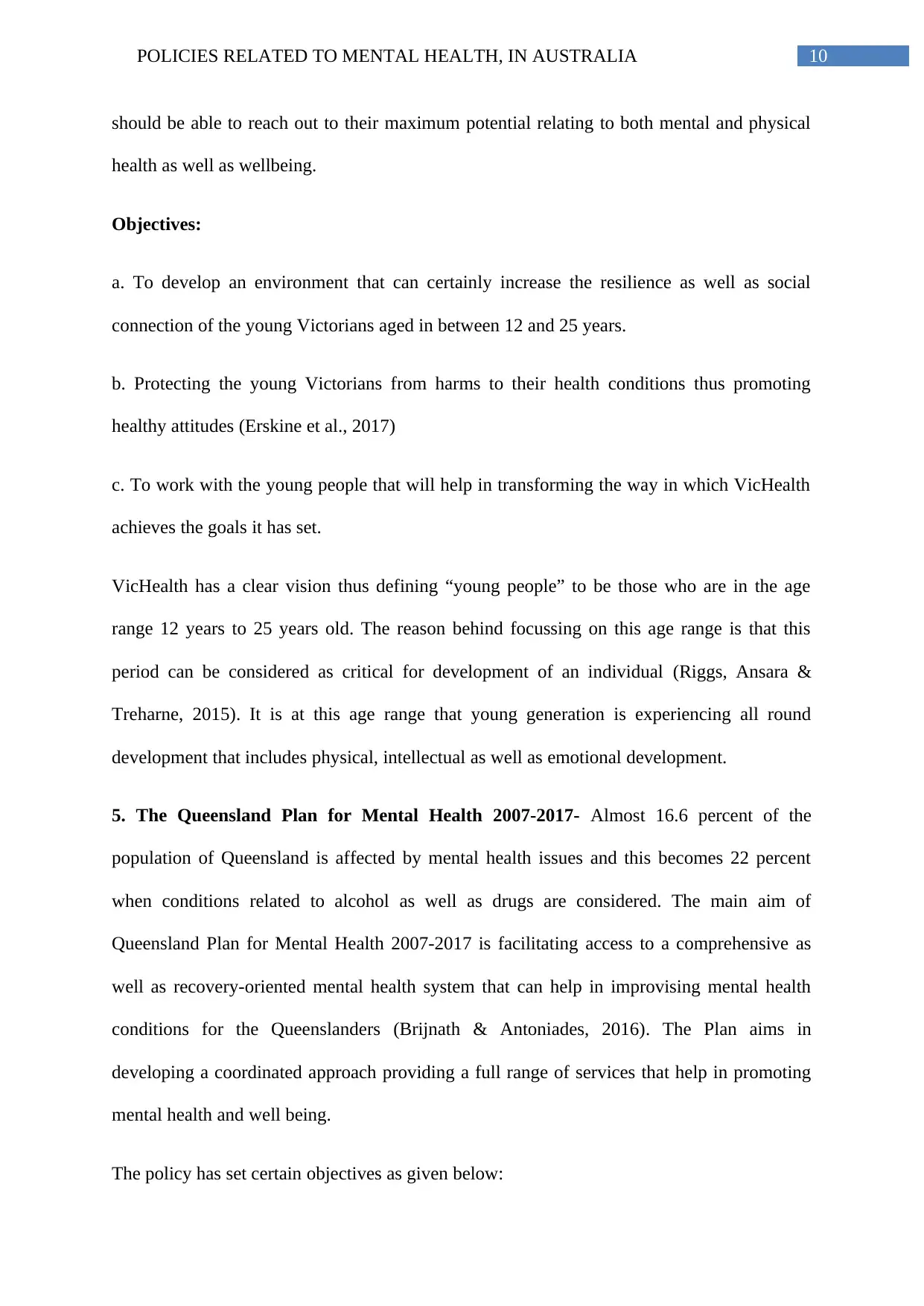
10POLICIES RELATED TO MENTAL HEALTH, IN AUSTRALIA
should be able to reach out to their maximum potential relating to both mental and physical
health as well as wellbeing.
Objectives:
a. To develop an environment that can certainly increase the resilience as well as social
connection of the young Victorians aged in between 12 and 25 years.
b. Protecting the young Victorians from harms to their health conditions thus promoting
healthy attitudes (Erskine et al., 2017)
c. To work with the young people that will help in transforming the way in which VicHealth
achieves the goals it has set.
VicHealth has a clear vision thus defining “young people” to be those who are in the age
range 12 years to 25 years old. The reason behind focussing on this age range is that this
period can be considered as critical for development of an individual (Riggs, Ansara &
Treharne, 2015). It is at this age range that young generation is experiencing all round
development that includes physical, intellectual as well as emotional development.
5. The Queensland Plan for Mental Health 2007-2017- Almost 16.6 percent of the
population of Queensland is affected by mental health issues and this becomes 22 percent
when conditions related to alcohol as well as drugs are considered. The main aim of
Queensland Plan for Mental Health 2007-2017 is facilitating access to a comprehensive as
well as recovery-oriented mental health system that can help in improvising mental health
conditions for the Queenslanders (Brijnath & Antoniades, 2016). The Plan aims in
developing a coordinated approach providing a full range of services that help in promoting
mental health and well being.
The policy has set certain objectives as given below:
should be able to reach out to their maximum potential relating to both mental and physical
health as well as wellbeing.
Objectives:
a. To develop an environment that can certainly increase the resilience as well as social
connection of the young Victorians aged in between 12 and 25 years.
b. Protecting the young Victorians from harms to their health conditions thus promoting
healthy attitudes (Erskine et al., 2017)
c. To work with the young people that will help in transforming the way in which VicHealth
achieves the goals it has set.
VicHealth has a clear vision thus defining “young people” to be those who are in the age
range 12 years to 25 years old. The reason behind focussing on this age range is that this
period can be considered as critical for development of an individual (Riggs, Ansara &
Treharne, 2015). It is at this age range that young generation is experiencing all round
development that includes physical, intellectual as well as emotional development.
5. The Queensland Plan for Mental Health 2007-2017- Almost 16.6 percent of the
population of Queensland is affected by mental health issues and this becomes 22 percent
when conditions related to alcohol as well as drugs are considered. The main aim of
Queensland Plan for Mental Health 2007-2017 is facilitating access to a comprehensive as
well as recovery-oriented mental health system that can help in improvising mental health
conditions for the Queenslanders (Brijnath & Antoniades, 2016). The Plan aims in
developing a coordinated approach providing a full range of services that help in promoting
mental health and well being.
The policy has set certain objectives as given below:
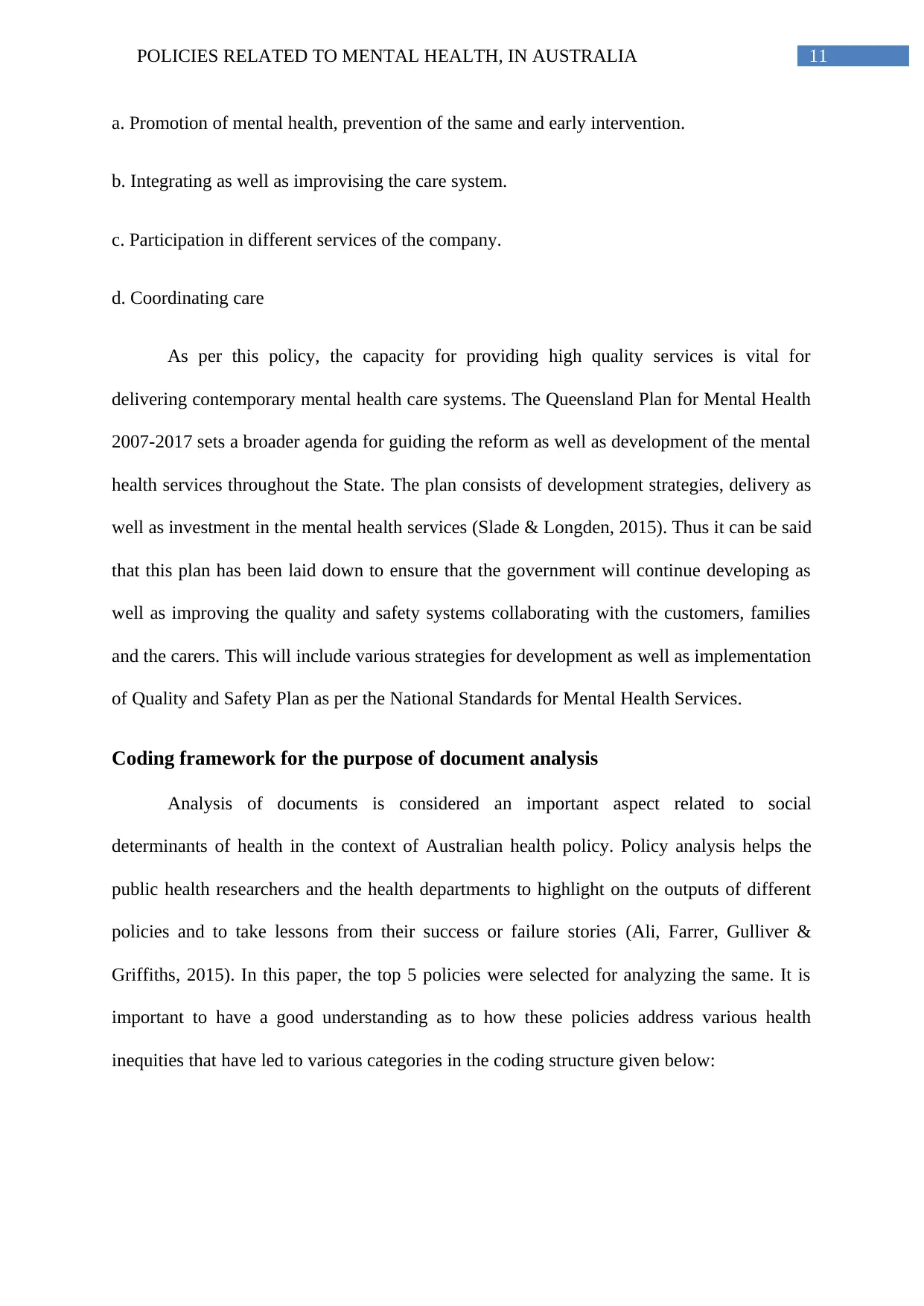
11POLICIES RELATED TO MENTAL HEALTH, IN AUSTRALIA
a. Promotion of mental health, prevention of the same and early intervention.
b. Integrating as well as improvising the care system.
c. Participation in different services of the company.
d. Coordinating care
As per this policy, the capacity for providing high quality services is vital for
delivering contemporary mental health care systems. The Queensland Plan for Mental Health
2007-2017 sets a broader agenda for guiding the reform as well as development of the mental
health services throughout the State. The plan consists of development strategies, delivery as
well as investment in the mental health services (Slade & Longden, 2015). Thus it can be said
that this plan has been laid down to ensure that the government will continue developing as
well as improving the quality and safety systems collaborating with the customers, families
and the carers. This will include various strategies for development as well as implementation
of Quality and Safety Plan as per the National Standards for Mental Health Services.
Coding framework for the purpose of document analysis
Analysis of documents is considered an important aspect related to social
determinants of health in the context of Australian health policy. Policy analysis helps the
public health researchers and the health departments to highlight on the outputs of different
policies and to take lessons from their success or failure stories (Ali, Farrer, Gulliver &
Griffiths, 2015). In this paper, the top 5 policies were selected for analyzing the same. It is
important to have a good understanding as to how these policies address various health
inequities that have led to various categories in the coding structure given below:
a. Promotion of mental health, prevention of the same and early intervention.
b. Integrating as well as improvising the care system.
c. Participation in different services of the company.
d. Coordinating care
As per this policy, the capacity for providing high quality services is vital for
delivering contemporary mental health care systems. The Queensland Plan for Mental Health
2007-2017 sets a broader agenda for guiding the reform as well as development of the mental
health services throughout the State. The plan consists of development strategies, delivery as
well as investment in the mental health services (Slade & Longden, 2015). Thus it can be said
that this plan has been laid down to ensure that the government will continue developing as
well as improving the quality and safety systems collaborating with the customers, families
and the carers. This will include various strategies for development as well as implementation
of Quality and Safety Plan as per the National Standards for Mental Health Services.
Coding framework for the purpose of document analysis
Analysis of documents is considered an important aspect related to social
determinants of health in the context of Australian health policy. Policy analysis helps the
public health researchers and the health departments to highlight on the outputs of different
policies and to take lessons from their success or failure stories (Ali, Farrer, Gulliver &
Griffiths, 2015). In this paper, the top 5 policies were selected for analyzing the same. It is
important to have a good understanding as to how these policies address various health
inequities that have led to various categories in the coding structure given below:
⊘ This is a preview!⊘
Do you want full access?
Subscribe today to unlock all pages.

Trusted by 1+ million students worldwide
1 out of 23
Related Documents
Your All-in-One AI-Powered Toolkit for Academic Success.
+13062052269
info@desklib.com
Available 24*7 on WhatsApp / Email
![[object Object]](/_next/static/media/star-bottom.7253800d.svg)
Unlock your academic potential
Copyright © 2020–2025 A2Z Services. All Rights Reserved. Developed and managed by ZUCOL.





